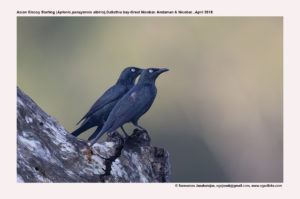
Asian Glossy Starling Aplonis panayensis
Etymology :
- Aplonis : Greek word haploos – simple, plain ; ornis –bird.
- Panayensis : From Philippines
Vernacular Names : Cachar: Dao gogoui, Dao maina gajeba, Nicobar: Tukkuliv
Distribution in India: Resident of Andaman & Nicobar Island, summer visitor in North East India.
Description: Size of 17–20 cm; Wt. of 50–60·5 g. it is a medium-sized starling with forehead feathers bristly and throat feathers lanceolate. The nominate race is black with greenish to oily gloss except on lowermost underparts, which are matt black. It has small black mask on lores and around eye; iris is red; bill and legs are black. Both the sexes are alike. The juvenile is initially dark chocolate-brown above, with some green gloss on wings, whitish below with dark feather shafts, appearing heavily streaked, iris is yellow, orange or pink; the gloss develops progressively, and iris changes gradually to red. Racetytleri is larger, darker and less glossy than previous, with gloss more bluish and iris often brown, pink or orange; race albiris has whitish iris.
Habitat: It is found in forest, forest edge and clearings, secondary growth, mangroves and coastal vegetation, also gardens and coconut plantation. It is found from lowlands up to 700 m
Food habits: When on land it eats fruit,nectar, insects, spiders, and snails. It is mainly arboreal, foraging often in tops of trees. It will eat fallen fruit on ground, and often descends to ground to capture insects. It feeds on large snails on ground, smashing them against hard objects to break the shells. It hawks termites in air. It is highly gregarious, feeding in flocks..
Breeding habits: They breed inFeb–Apr in North East India, Apr in Andaman and Nicobar, Mar–Jun in Myanmar, Jan–Aug in Peninsular Malaysia, Jan–Jun in Java and Bali, mainly Jun–Sept in Borneo, and Feb–Jun in Philippines. The nest is a rough cup of roots, grass and leaves, placed in natural cavity or old woodpecker hole in living or dead tree, in crown of palm tree, or in hole in cliff or bank, including hole excavated by kingfisher. They lay a clutch of 3 eggs.